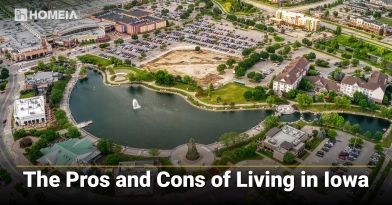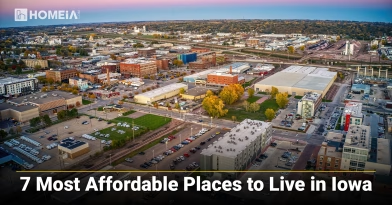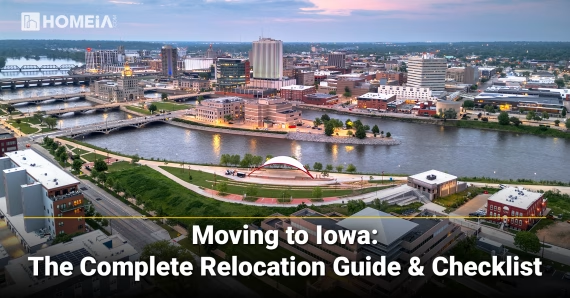The 5 Best Places to Live in Iowa: A City Comparison
- Local Editor:Local Editor: The HOMEiA Team
Published: Nov 13, 2025
- Category: City Living Guide

Iowa is a state of agricultural abundance, friendly communities, and surprising urban sophistication. Choosing the right community within the Hawkeye State is crucial to unlocking a lifestyle that fits your ambitions, no matter the goal.
This guide provides an in-depth, data-driven analysis of the five best places to live in Iowa for 2025. We’ve moved past simple charm to evaluate these population centers on the factors that matter most: economic opportunity, affordability, safety, access to amenities, and unique quality of life. From the vibrant capital of Des Moines to the academic haven of Iowa City, we break down what makes each city a premier destination for building your future in the Midwest.
For those considering other states, you might also explore our comparison of the pros and cons of living in Washington State.
Table of Contents:
Key Takeaways
- Diverse Options for Diverse Needs: These top cities offer distinctly different lifestyles, from the economic hub of Des Moines to the tight-knit, education-focused community of Iowa City.
- Affordability is a Constant: A major advantage across all five cities is a cost of living below the national average, with accessible housing costs compared to other Midwestern states.
- Safety Varies Significantly: Safety ratings range from excellent to moderate, making it crucial to research specific neighborhoods and cities based on your personal tolerance and priorities.
- Economic Drivers Differ: Each city’s job market is anchored by a different sector—insurance, education, manufacturing, healthcare, or agriculture—requiring alignment with your career field.
- Community is Key: The intangible sense of place, community engagement, and access to culture and nature are often the defining factors in choosing between these exceptional locations.
I. Methodology: How We Chose the Best
To ensure a comprehensive and objective ranking, our analysis is based on a multi-factor methodology evaluating each city on key criteria essential for quality of life in the Iowa context.
Our evaluation criteria are weighted as follows:
- Employment & Economy (25%): Assesses job market health, major employers, economic diversity, and income levels relative to local cost of living.
- Housing & Affordability (25%): Evaluates median home value, average rent, and home-price-to-income ratios, acknowledging Iowa’s overall affordability but important local variations.
- Quality of Life & Culture (20%): Encompasses access to unique outdoor recreation, cultural attractions, dining, entertainment, and overall lifestyle.
- Access & Infrastructure (15%): Considers connectivity (road, air), healthcare access, internet reliability, and other critical services.
- Safety & Community (15%): Reviews crime statistics and overall community engagement, resilience, and family-friendliness.
Data is compiled from reputable 2025 sources, including the U.S. Census Bureau, Bureau of Labor Statistics, FBI crime data, and real estate market analyses (Zillow, local MLS).
Our Methodologies to create HOMEiA Score Ratings for Each Group of Content
HOMEiA uses a consistent, data-driven methodology to evaluate U.S. states for livability, affordability, and long-term value. Our analysis centers on key factors such as Housing and Affordability, Cost of Daily Living, Access and Infrastructure, Community Strength, Safety and Quality of Life, Economic Resilience and Job Market Performance…
II. The 5 Best Cities: A Portrait of Iowa’s Diversity
1. Dubuque: The River City
HOMEiA Score: 82/100
- Cost of Living: 15% below U.S. average
- Monthly Rent: $850
- Home price to income ratio: 3.8:1
- Income to rent ratio: 58.8x
- Safety rating: 72/100
A. Employment & Economy: Dubuque’s economy has transformed from manufacturing to diverse sectors including healthcare, education, and tech. Major employers include MercyOne Dubuque Medical Center, John Deere, and several insurance companies. A riverfront location supports tourism and logistics industries.
B. Housing & Affordability: The Dun offers outstanding affordability with a home-price-to-income ratio of 3.8:1 and cost of living 15% below the national average. Still in-tact are historic housing in bluffs neighborhoods, riverfront properties, and suburban developments at exceptionally accessible prices.
C. Quality of Life & Culture: Boasting a stunning Mississippi River setting with the National Mississippi River Museum & Aquarium, historic architecture, and vibrant arts scene are present. Residents enjoy outdoor activities along the riverfront, in city parks, and at nearby ski resorts. A revitalized downtown offers dining, entertainment, and cultural events.
D. Access & Infrastructure: As a tri-state area hub, this area has comprehensive infrastructure including a regional airport (DBQ), healthcare systems, and transportation networks. Serving northeastern Iowa, northwestern Illinois, and southwestern Wisconsin means having modern amenities.
E. Safety & Community: With a safety rating of 72/100, it maintains safe neighborhoods and an ideal sense of community. Their historic preservation and riverfront development demonstrate community pride and engagement across generations.
Moving to Iowa: The Complete Relocation Guide & Checklist
Bordered by six states, Iowa combines rolling plains, vibrant cities, and a strong sense of community. Home to 3.2 million people, it offers affordable living, great schools, and steady employment. This guide provides key relocation insights, from costs and climate to the benefits of settling in the welcoming Hawkeye State.
2. Cedar Rapids: The Industrial Innovator
HOMEiA Score: 84/100
- Cost of Living: 12% below U.S. average
- Monthly Rent: $950
- Home price to income ratio: 4.0:1
- Income to rent ratio: 55.8x
- Safety rating: 68/100
A. Employment & Economy: Cedar Rapids serves as Iowa’s manufacturing and aerospace hub, anchored by major employers including Collins Aerospace and General Mills. This has diversified into tech, healthcare, and professional services while maintaining its industrial strength. Economic diversity provides stability and opportunity across multiple sectors.
B. Housing & Affordability: The Rapids offers exceptional value with a home-price-to-income ratio of 4.0:1 and cost of living 12% below the national average. Providing a range of housing options from historic neighborhoods to new developments, all at prices that make homeownership accessible for working families.
C. Quality of Life & Culture: CR boasts cultural attractions including the Cedar Rapids Museum of Art, Paramount Theatre, and the Czech Village. Residents enjoy outdoor activities along the Cedar River and in numerous parks. Their revitalized downtown offers dining, entertainment, and community events.
D. Access & Infrastructure: As Iowa’s second-largest city, comprehensive infrastructure exists including the Eastern Iowa Airport (CID), major healthcare systems, and excellent transportation networks. Serving as a regional hub for eastern Iowa, it’s equipped with modern amenities and services.
E. Safety & Community: With a safety rating of 68/100, this area maintains safe neighborhoods and a rooted sense of community. The city has rebounded impressively from historic flooding, demonstrating resilience and community spirit that continues to define its character.
Recommended for you
3. Ames: The Research Hub

HOMEiA Score: 85/100
- Cost of Living: 7% below U.S. average
- Monthly Rent: $1,100
- Home price to income ratio: 4.5:1
- Income to rent ratio: 54.5x
- Safety rating: 75/100
A. Employment & Economy: Ames is dominated by Iowa State University, a leading research institution in agriculture, engineering, and veterinary medicine. Academia drives employment in education, research, and innovation transfer, while USDA’s National Animal Disease Center provides additional scientific employment. The city has growing tech and startup sectors.
B. Housing & Affordability: With a home-price-to-income ratio of 4.5:1, there exists ideal value while benefiting from university amenities. Housing options range from student accommodations to family neighborhoods, all at prices that reflect the city’s educated workforce and stable economy.
C. Quality of Life & Culture: Ames offers a college town atmosphere with Big 12 athletics, cultural events, and the Reiman Gardens. An educated population supports exceptional schools, libraries, and community programs. Outdoor enthusiasts enjoy nearby parks, trails, and recreational facilities.
D. Access & Infrastructure: Located north of Des Moines, residents enjoy proximity to the capital while maintaining a unique identity. Possessing modern infrastructure, comprehensive healthcare services, and reliable utilities supporting both university and community needs.
E. Safety & Community: With a safety rating of 75/100, it ranks among Iowa’s safest cities. Community members are highly educated, engaged, and family-oriented, with strong neighborhood associations and a collaborative spirit fostered by the university environment.
The Pros and Cons of Living in Iowa
Iowa is more than farmland and rolling hills—it’s a state built on community, affordability, and Midwestern charm. However, challenges like cold winters, fewer entertainment options, and agricultural reliance remain. This guide explores Iowa’s pros and cons, plus its best cities for professionals, families, and retirees seeking balanced Midwest living.
4. Iowa City: The Academic Center

HOMEiA Score: 86/100
- Cost of Living: 5% below U.S. average
- Monthly Rent: $1,250
- Home price to income ratio: 5.8:1
- Income to rent ratio: 48.0x
- Safety rating: 70/100
A. Employment & Economy: Iowa City’s economy revolves around the University of Iowa, one of the nation’s premier research institutions and home to the renowned Iowa Writers’ Workshop. U of I drives employment in education, healthcare, and research, while the city’s vibrant literary scene supports creative industries. The University of Iowa Hospitals and Clinics is a major employer and regional medical center.
B. Housing & Affordability: Home-price-to-income ratio at 5.8:1 reflects the city’s desirability and university influence. IC offers a mix of historic homes near downtown, student housing, and suburban neighborhoods. While more expensive than other cities, it remains affordable compared to similar university towns nationally.
C. Quality of Life & Culture: Iowa City is a UNESCO City of Literature with a rich cultural scene including independent bookstores, literary events, and the Englert Theatre. The university brings Big Ten athletics, performing arts, and academic events. Iowa River and nearby parks provide beautiful outdoor spaces for recreation.
D. Access & Infrastructure: Located along I-80, this city enjoys ideal connectivity while maintaining its distinct character. Comprehensive healthcare through the university hospital system and modern infrastructure support academic and community needs.
E. Safety & Community: With a safety rating of 70/100, here offers a secure environment with an educated, engaged population. The community blends students, faculty, healthcare professionals, and long-term residents in a collaborative atmosphere focused on education and culture.
7 Most Affordable Places to Live in Iowa (updated)
Iowa offers more than farmland and friendly faces—it’s one of the most affordable states to call home. With low housing costs and a stable economy, it’s ideal for families, retirees, and remote workers. This guide highlights seven budget-friendly Iowa communities for 2025, balancing cost, comfort, and Midwestern charm.
5. Des Moines: The Economic Powerhouse
HOMEiA Score: 88/100
- Cost of Living: 8% below U.S. average
- Monthly Rent: $1,150
- Home price to income ratio: 4.2:1
- Income to rent ratio: 52.2x
- Safety rating: 65/100
A. Employment & Economy: Des Moines is Iowa’s economic engine and a national insurance hub, with campuses for major companies including Principal Financial Group, Nationwide, and Wells Fargo. Extending beyond this include sectors in finance, healthcare, tech, and professional services. With a growing startup scene and corporate headquarters, the capital offers the state’s most dynamic job market with opportunities across multiple industries.
B. Housing & Affordability: Here provides exceptional value with a home-price-to-income ratio of 4.2:1, indicating desirable purchasing power for residents. It offers diverse housing options from historic neighborhoods like Sherman Hill to modern downtown condos and suburban developments. Despite being the state’s largest city, housing remains affordable compared to other state capitals.
C. Quality of Life & Culture: Here offers a vibrant urban experience with the Downtown Farmers’ Market, Des Moines Art Center, and the Pappajohn Sculpture Park. Residents enjoy professional sports with the Iowa Cubs (baseball), Iowa Wolves (basketball), and Iowa Wild (hockey), plus numerous festivals and cultural events throughout the year. An extensive trail system and parks provide excellent outdoor recreation.
D. Access & Infrastructure: Being a focal point for the state offers comprehensive infrastructure including an international airport (DSM), major healthcare systems, and ideal transportation networks. The city serves as the commercial and logistical hub for the entire state with modern amenities and services.
E. Safety & Community: With a safety rating of 65/100, DM has safe neighborhoods alongside urban challenges typical of a growing city. Their is engaged and diverse, with strong neighborhood associations and a welcoming atmosphere for newcomers. Family-friendly suburbs like West Des Moines and Waukee offer additional safety options.
Comparative Data Table
City | HOMEiA Score | Cost of Living | Avg. Rent (2-Bed) | Home Price to Income Ratio | Income to Rent Ratio | Safety Rating |
|---|---|---|---|---|---|---|
| Dubuque | 82 | -15% | $850 | 3.8:1 | 58.8x | 72 |
| Cedar Rapids | 84 | -12% | $950 | 4.0:1 | 55.8x | 68 |
| Ames | 85 | -7% | $1,100 | 4.5:1 | 54.5x | 75 |
| Iowa City | 86 | -5% | $1,250 | 5.8:1 | 48.0x | 70 |
| Des Moines | 88 | -8% | $1,150 | 4.2:1 | 52.2x | 65 |
Conclusion: Finding Your Perfect Iowa Match
The best Iowa city depends on your priorities. Des Moines delivers urban energy and diverse careers, while Iowa City offers academic excellence and cultural richness. Cedar Rapids provides industrial strength and exceptional value, and Ames combines research opportunities with safety. Dubuque offers historic charm and outstanding affordability in a beautiful river setting.
Each location presents a unique trade-off between cost, opportunity, and lifestyle. An ideal choice hinges on aligning these factors with your personal, financial, and professional goals for life in the Hawkeye State. For those still considering options, our guide to the best places to live in Wisconsin might provide additional insights for Midwestern living.
Recommended for you
FAQs About Living in Iowa’s Best Cities
A. Which city has the best job market? Des Moines has the largest, most diverse job market in Iowa, spanning insurance, finance, healthcare, and technology. Cedar Rapids offers proven manufacturing and aerospace opportunities, while Iowa City and Ames provide academic and research positions.
B. I’m a remote worker. Where should I move? For the best blend of reliable infrastructure, amenities, and culture, Des Moines is an excellent choice. For more affordable living with a strong internet and community atmosphere, consider Cedar Rapids or Dubuque. Always confirm internet reliability at your specific address before moving.
C. Are these cities safe? Safety varies but all five cities maintain good safety profiles. Ames has the highest safety rating (75/100), followed by Dubuque (72/100) and Iowa City (70/100). Des Moines (65/100) has safe neighborhoods alongside urban challenges typical of a growing capital city.
D. What’s the best city for young professionals? Des Moines offers the most vibrant social scenes, networking opportunities, and diverse career paths for young professionals. Iowa City provides a youthful, educated atmosphere with cultural opportunities from the university.
E. What’s the best city for families? Families often choose based on schools and safety. Ames offers exceptional schools and the highest safety rating (75/100) with a family-friendly university environment. Dubuque provides outstanding affordability and safety (72/100) in a beautiful river setting with strong community values.
For those exploring other Midwestern options, you might also consider the pros and cons of living in Wisconsin, or if you’re interested in more urban environments, check out our guide to the best places to live in Illinois. Those considering the West might explore the pros and cons of living in Colorado, while families might find our analysis of the best places to live in Minnesota helpful.
HOMEiA is a city guide site where visitors can find detailed information about communities of interest. HOMEiA’s City Guides, created in partnership with local writers and editors, are curated lists of the best, safest, and most affordable places to live. The guides feature the HOMEiA Score, a proprietary index that rates communities on such factors as housing costs, education, employment, etc.
HOMEiA.com aims to be the premier site for people planning to relocate, providing them with insightful content and connecting them with skilled real estate professionals.
We also empower real estate professionals to establish or strengthen their web presence by highlighting their experience, knowledge and achievements. If you’re selected to join our list of certified real estate professionals, you will distinguish yourself from your peers — and earn HOMEiA’s support.
If you believe in HOMEiA’s mission, please share our website with others.





































































































































